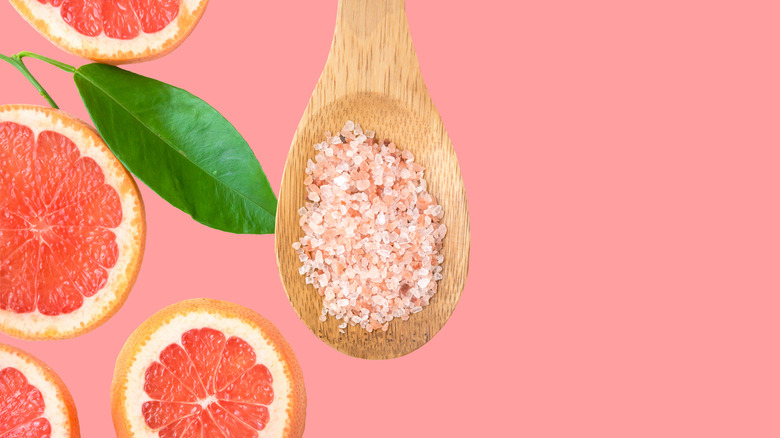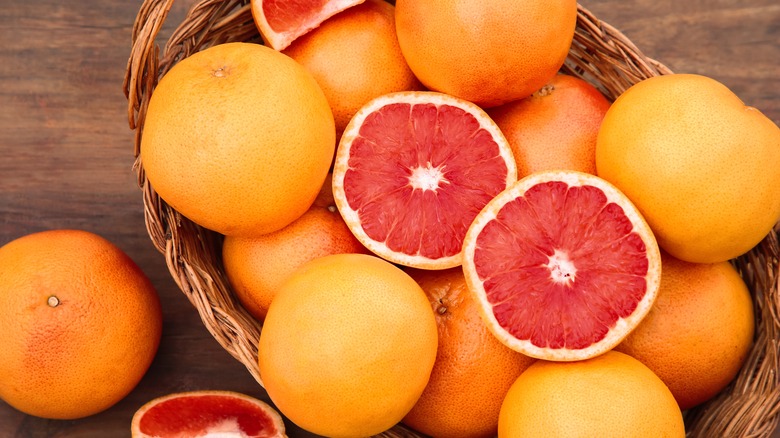How Salting Grapefruit Tricks Your Taste Buds
Grapefruit tops the list of fruits relatively low in sugar, which may not come as a surprise to anyone who has scooped out spoonfuls of the tart and sometimes bitter citrus fruit as part of their breakfast routine. Its low sugar content would seem to be a solid reason for grapefruit's bitterness but, in fact, a handful or two of strawberries has about the same amount of sugar, yet most would likely agree that the berries typically taste significantly sweeter. Instead, grapefruit's naturally occurring compound naringin accounts for its sharp flavor.
If you're among the fruit-lovers who want to enjoy all the benefits of eating grapefruit (like tons of vitamins C and A as well as a good bit of potassium, folate, and lycopene), but don't want to dump piles of sugar on top to sweeten it, you're in luck. Instead of increasing your calorie count to combat the bitterness caused by naringin, you can improve the flavor of the healthy fruit and make it taste sweeter with a sprinkle of salt.
Salt helps to enhance the flavors of other ingredients, and it can do the same for your grapefruit in the same way it does other sweet treats (you may have noticed that salt is a crucial ingredient when baking).
Why adding salt can make grapefruit taste sweeter
It may seem more commonplace to sprinkle salt on savory foods like fries or meat to add flavor, but using a small amount of the simple seasoning works wonders for creating the illusion of increased sweetness, too. As it turns out, salt's chemical makeup causes it to act as an inhibitor of bitter flavors when coming into contact with taste buds, and salt's ability to cancel out some of the bitterness results in the perception of a food being sweeter.
But, while salting a bitter grapefruit can improve its palatability, it's important to use it in moderation. Unlike spreading a thick layer of sugar over the top of the fruit to cover up its bitterness, just a small sprinkle of salt should be enough to trick your taste buds into telling your brain that the fruit is sweeter than it is.
And, of course, not all grapefruits are created equal. Some varieties, like pink and red grapefruit, contain less naringin than their white counterparts, making them significantly sweeter naturally. So, just as you would taste your savory foods before pulling out the salt shaker, sample your grapefruit before sprinkling salt on top.
Naringin's benefits and where to find it
While you can easily solve the problem of bitter grapefruit by reaching for a darker-colored variety, which has less naringin and will likely be sweeter, you may want to consider the fact that research suggests that eating naringin may result in remarkable health benefits. The National Institute of Health has published work that details the compound's potential to possibly help battle conditions that range from obesity and diabetes to hypertension. The journal also suggests that naringin is abundant in antioxidants and has anti-inflammatory properties as well.
While eating grapefruit may be one of the top ways to infuse naringin into your diet, you can also find it in tart cherries and sour oranges as well as tomatoes. More trace amounts of the compound are also in beans, bergamot, and cocoa.
So, the next time you're wavering on whether you want to start the day with a tart grapefruit, just consider the healthy goodness that bitterness is bringing to the table and reach for your salt shaker to trick your tongue into thinking it's getting something sweet.



